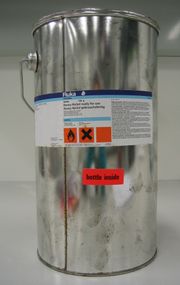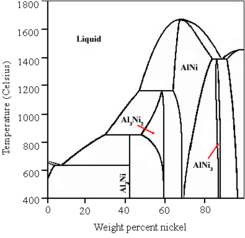Raney nickel
2007 Schools Wikipedia Selection. Related subjects: Chemical compounds
Raney nickel is a solid catalyst composed of fine grains of a nickel-aluminium alloy, used in many industrial processes. It was developed in 1926 by American engineer Murray Raney as an alternative catalyst for the hydrogenation of vegetable oils in industrial processes. More recently it is used as a heterogeneous catalyst in a variety of organic syntheses, most commonly for hydrogenation reactions.
Raney nickel is produced when a block of nickel-aluminium alloy is treated with concentrated sodium hydroxide. This treatment, called "activation", dissolves most of the aluminium out of the alloy. The porous structure left behind has a large surface area, which gives high catalytic activity. A typical catalyst is around 85-percent nickel by mass, corresponding to about two atoms of nickel for every atom of aluminium. The aluminium which remains helps to preserve the pore structure of the overall catalyst.
Since Raney is a registered trademark of W. R. Grace and Company, only those products by its Grace Davison division are properly called "Raney nickel". Alternatively, the more generic terms " skeletal catalyst" or "sponge-metal catalyst" may be used to refer to catalysts that have physical and chemical properties similar to those of Raney nickel.
Preparation
Alloy preparation
Alloys are prepared commercially by melting the active metal (nickel in this case, but iron and copper "Raney-type" catalysts can be prepared as well) and aluminium in a crucible and quenching the resultant melt, which is then crushed into a fine powder. This powder may be screened for a specific particle size range depending on the application the catalyst may be required for.
The initial alloy composition is important because the quenching process produces a number of different Ni/Al phases that have different leaching properties. This may result in markedly different porosities in the end product. The most common starting alloy used in industry contains an equal amount per weight of nickel and aluminium, incidentally, the same ratio Murray Raney used in his discovery of Raney nickel.
During the quenching procedure, small amounts of a third metal, such as zinc or chromium, may be added. This is done to enhance catalytic activity, and as such this third metal is called a " promoter". Note that the addition of a promoter changes the alloy and its resulting phase diagram to that of a ternary alloy, leading to different quenching and leaching properties during activation.
Activation
The porous structure of the catalyst arises from the selective removal of aluminium from alloy particles using aqueous sodium hydroxide. The simplified leaching reaction is given by the following chemical equation:
- 2Al + 2NaOH + 6H2O → 2Na[Al(OH)4] + 3H2
The formation of sodium aluminate (Na[Al(OH)4]) requires that solutions of high concentration of sodium hydroxide are used in order to avoid the formation of aluminium hydroxide, which precipitates as bayerite. Hence sodium hydroxide solutions with concentrations of up to 5 molar are used. Bayerite may cause blocking of the pores formed during leaching, and with the subsequent loss of surface area, it can reduce the efficiency and activity of the catalyst.
The temperature used to leach the alloy has a marked effect on the surface properties of the catalyst. Commonly used temperatures range from 70 to 100 ° C. The surface area of Raney nickel (and skeletal catalysts in general) tends to decrease with increasing leaching temperature. This is due to structural rearrangements within the alloy that may be considered analogous to sintering, where alloy ligaments would start adhering to each other at higher temperatures leading to the loss of the porous structure.
Before storage, the catalyst can be washed with distilled water at ambient temperature in order to remove any remaining traces of sodium aluminate. Oxygen-free water is preferred for storage in order to prevent oxidation of the catalyst, which would accelerate its aging process and result in reduced catalytic activity.
Properties
Macroscopically Raney nickel looks like a finely divided gray powder. Microscopically, each particle of this powder looks like a three-dimensional mesh, with pores of irregular size and shape of which the vast majority are created during the leaching process. Raney nickel is notable for being thermally and structurally stable as well has having a large BET surface area. These properties are a direct result of the activation process and contribute to a relatively high catalytic activity.
During the activation process, aluminium is leached out the NiAl3 and Ni2Al3 phases that are present in the alloy, while most of the aluminium that remains does so in the form of NiAl. The removal of aluminium from some phases but not others is known as " selective leaching". It has been shown that the NiAl phase provides the structural and thermal stability to the catalyst. As a result the catalyst is quite resistant to decomposition ("breaking down", commonly known as "aging"). This resistance allows Raney nickel to be stored and reused for an extended period; however, fresh preparations are usually preferred for laboratory use. For this reason commercial Raney nickel is available in both "active" and "inactive" forms.
The surface area is typically determined via a BET measurement using a gas that will be preferentially adsorbed on metallic surfaces, such as hydrogen. Using this type of measurement, it has been shown that almost all the exposed area in a particle of the catalyst has nickel on its surface. Since nickel is the active metal of the catalyst, a large nickel surface area implies that there is a large surface available for reactions to occur simultaneously, which is reflected in an increased catalyst activity. Commercially available Raney nickel has an average nickel surface area of 100 m² per gram of catalyst.
A high catalytic activity, coupled with the fact that hydrogen is absorbed within the pores of the catalyst during activation, makes Raney nickel a useful catalyst for many hydrogenation reactions. Its structural and thermal stability (i.e., the fact that it does not decompose at high temperatures) allows its use under a wide range of reaction conditions. Additionally, the solubility of Raney nickel is negligible in most common laboratory solvents, with the exception of mineral acids such as hydrochloric acid, and its relatively high density (between 6 or 7 g/cm³) also facilitates its separation off a liquid phase after a reaction is completed.
Applications
Raney nickel is used in a large number of industrial processes and in organic synthesis because of its stability and high catalytic activity at room temperature. It is typically used in the reduction of compounds that have multiple bonds, such as alkynes, alkenes, nitriles, dienes, aromatics and carbonyls. Additionally, Raney nickel will reduce heteroatom-heteroatom bonds such as nitro groups, and nitrosamines. (For further information see Reduction of nitro compounds.) It has also found use in the reductive alkylation of amines and the amination of alcohols.
A practical example of the use of Raney nickel in industry is shown in the following reaction, where benzene is reduced to cyclohexane. Reduction of the aromatic structure of the benzene ring is very hard to achieve through other chemical means, but can be effected by using Raney nickel. Other heterogeneous catalysts, such as those using platinum group elements, may be used instead to similar effect, but these tend to be more expensive to produce than Raney nickel. After this reaction cyclohexane may be used in the synthesis of adipic acid, a raw material used in the industrial production of polyamides such as nylon.
When reducing a carbon-carbon double bond, Raney nickel will add hydrogen in a syn fashion.
In addition to being a catalyst, Raney nickel will also act as a reagent to desulfurize organic compounds. For example, thioacetals will be reduced to hydrocarbons:
Nickel sulfide will precipitate as millerite, while ethane can be easily separated through distillation. Similar transformations are the Clemmensen reduction and the Wolff-Kishner reduction.
Safety
Due to its large surface area and high volume of contained hydrogen gas, dry, activated Raney nickel is a pyrophoric material that should be handled under an inert atmosphere. Raney nickel is typically supplied as a 50-percent slurry in water. Care should be taken never to expose Raney nickel to air. Even after reaction, Raney nickel contains significant amounts of hydrogen gas, and will ignite when exposed to air.
Raney nickel will produce hazardous fumes when burning, and therefore the use of a gas mask is recommended when extinguishing fires caused by it. Additionally, acute exposure to Raney nickel may cause irritation of the respiratory tract, nasal cavities and pulmonary fibrosis if inhaled. Ingestion may lead to convulsions and intestinal disorders. It can also cause eye and skin irritation. Chronic exposure may lead to pneumonitis and other signs of sensitization to nickel like skin rashes ("nickel itch").
Nickel is also rated as being a possible human carcinogen by the ( IARC Group 2B, EU category 3) and teratogen, while the inhalation of fine aluminium oxide particles is associated with Shaver's disease. Care should be taken when handling these raw materials during laboratory preparation of Raney nickel. Moreover, activation of Raney nickel produces large amounts of hydrogen gas as a by-product, which is also highly flammable.
Development
Murray Raney graduated as a Mechanical Engineer from the University of Kentucky in 1909. In 1915 he joined the Lookout Oil and Refining Company in Tennessee and was responsible for the installation of electrolytic cells for the production of hydrogen which was used in the hydrogenation of vegetable oils. During that time the industry used a nickel catalyst prepared from nickel(II) oxide. Believing that better catalysts could be produced, around 1921 he started to perform independent research while still working for Lookout Oil. In 1924 a 1:1 ratio Ni/Si alloy was produced, which after treatment with sodium hydroxide, was found to be five times more active than the best catalyst used in the hydrogenation of cottonseed oil. A patent for this discovery was issued in December 1925.
Subsequently, Raney produced a 1:1 Ni/Al alloy following a procedure similar to the one used for the nickel-silicon catalyst. He found that the resulting catalyst was even more active and filed a patent application in 1926. It may be of interest to note that Raney's choice of nickel-aluminium ratio was fortuitous and without any real scientific basis. However, this is the preferred alloy composition for production of Raney nickel catalysts currently in use.
Following the development of Raney nickel, other alloy systems with aluminium were considered, of which the most notable include copper, ruthenium and cobalt. Further research showed that adding a small amount of a third metal to the binary alloy would promote the activity of the catalyst. Some widely used promoters are zinc, molybdenum and chromium. Recently, a way of preparing enantioselective Raney nickel has been devised by surface adsorbtion of tartaric acid.






